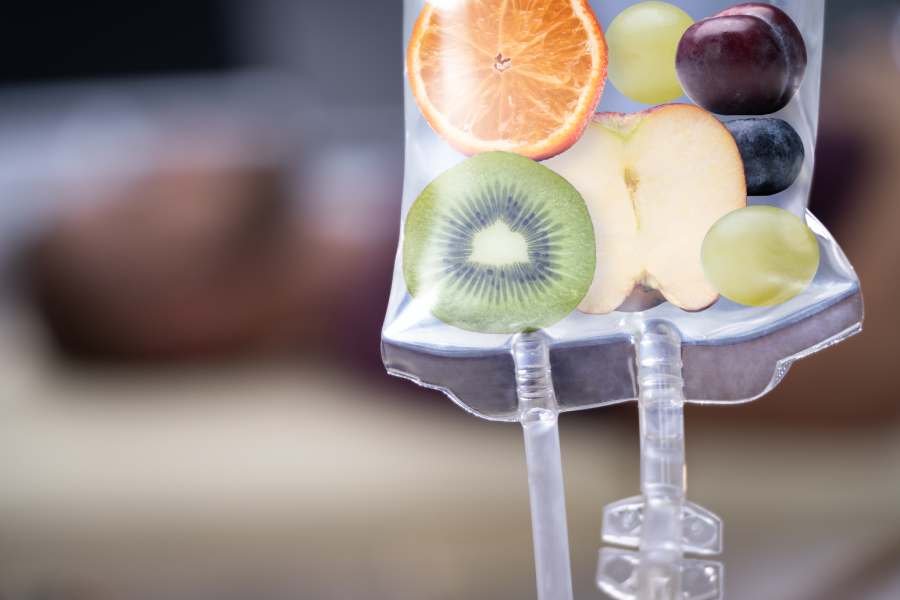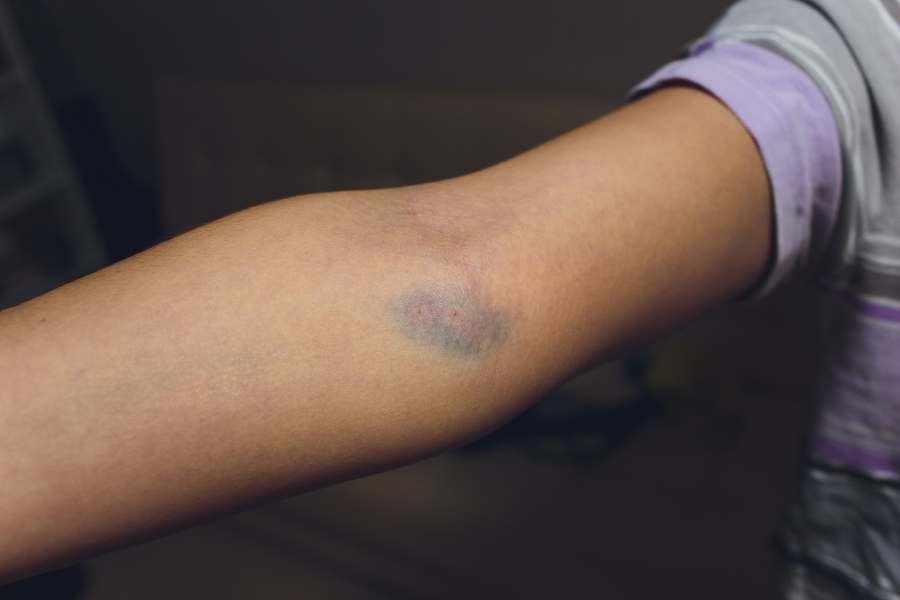IV therapy is commonly used in hospital settings to help patients get back on their feet more quickly. But IV therapy is no longer limited and is now also available outside the hospital.
You might have heard the claims that IV drips are one of the most exciting treatments in wellness. And before you try them out yourself, it is only understandable to wonder what are the vitamin IV therapy pros and cons.
This post will reveal both the positives and the negatives of mobile IV therapy and discuss cost and insurance coverage as well.
So, let’s begin.

Source: shutterstock.com/ Photo Contributor: Andrey_Popov
Vitamin IV Therapy Advantages and Disadvantages
Vitamin IV therapy is an intravenous vitamin therapy that delivers high concentrations of vitamins and minerals directly into the bloodstream. So, as its popularity rises, many are eager to understand the IV nutrient therapy benefits. However, this type of therapy doesn’t come without its cons.
Although the pros outweigh the cons, it’s still important to stay well-informed and understand how to effectively address any potential concerns.
We will look deeper to give you a more comprehensive understanding of the potential pros and cons of intravenous vitamin infusion. Throughout the sections below, we will discuss the potential positives and negatives of vitamin IV therapy.
What are the benefits of vitamin IV therapy
Hydration
One of the main benefits that vitamin IV therapy may offer is rapid rehydration and replenishment. This type of vitamin therapy is especially convenient for individuals who are unable to adequately hydrate by drinking liquids. Simply put, IV therapy is a water-based solution with added electrolytes.
Aids nutritional deficiency
There are times when our bodies need a bit more than the standard nutrients and vitamins. For example, when we come down with a cold or the flu, our body needs as many nutrients as possible for a fast recovery.
However, we are limited in the amount of vitamins that we can take orally without facing any negative consequences such as constipation. Vitamin IV therapy is a possible way to work around this issue and offer our body support and the fastest recovery possible.
Additionally, compared to oral intake, vitamin IV therapy allows for faster vitamin and mineral absorption. Taking vitamins orally means that they need to pass through the digestive system, while vitamin drips transfer the nutrients straight into the bloodstream.
This means that the vitamins through vitamin IV therapy may reach your cells easily for maximum impact. It is said that we can achieve around 90% vitamin absorption when administered intravenously.
On the other hand, oral vitamin intake achieves around 50% absorption due to the vitamins being broken down in the digestive tract.
IV drip benefits for skin
Vitamin deficits often stand behind problems such as hair loss, brittle nails, and skin problems. While the essential goal of IV drip might be rehydration, many will agree that the second biggest potential benefit IV therapy may offer is actually skin radiance.
Although no relevant research points to anti-aging IV drip benefits for the skin, we know that vitamin IV therapy may leave you both feeling and looking better. Most IV drips are designed with vitamins and ingredients that aid the skin differently.
Vitamin C plays a role in collagen formation. While collagen is one of the primary building blocks of the skin and helps it keep it vital by aiding its flexibility and elasticity.
Glutathione can help improve skin tone and clarity. It can also reduce cellular damage and lessen oxidative stress.
B Complex vitamins offer a plethora of skin and hair benefits. They are most well-known for their antioxidant properties.
Magnesium sulfate is a mineral that helps lower cortisol levels. Cortisol is the primary stress hormone, and as this NIH study shows, stress is directly linked to your skin’s health and appearance.
Improved cardiovascular health
Depending on the ingredients in the IV drip, this type of therapy can have a positive effect on your cardiovascular health. Certain minerals, such as calcium and magnesium, have a role in contracting and dilating the blood vessels. While certain amino acids like nitric oxide may help relax the blood vessels.

Source: shutterstock.com/ Photo Contributor: megaflopp
Elevating energy levels
Another one of the most prominent IV nutrient therapy benefits is the energy boost. Some IV drips are specially designed to enhance your energy levels. These usually contain a blend of vitamins, antioxidants, and electrolytes that can help battle fatigue and low energy. Athletes usually prefer this type of IV drip before or after a big event.
Energy-boosting IV therapy usually contains IV fluids, vitamin B12, B complex, vitamin C, and Taurine. Let’s break down why these vitamins are used for enhanced energy levels in the body:
B vitamins can help reduce stress and improve cognitive performance.
Taurine supplementation can help regulate your mood and improve focus.
Vitamin C can help tackle fatigue and help modulate stress.
Healthy weight support
This type of IV therapy is designed to help support your weight loss journey. While solely administering the vitamin IV therapy won’t particularly show any signs of losing weight, it may be great when combined with regular exercise and a balanced diet, and it may work wonders on your body.
Most vitamin IV weight loss packs contain ingredients that help detoxify the body and boost your metabolism. Even though each manufacturer creates a distinctive vitamin IV therapy mix, most IV drips for weight loss contain various vitamins and minerals, including Vitamin C, B-12, B-complex, chromium, magnesium, and many more. Besides vitamins to boost your metabolism, this IV therapy may contain lipotropics and hydrating fluids.
Hangover management
The vitamin IV therapy treatment is a blend of fluids, vitamins, electrolytes, and medications that may help overcome a hangover.
Hangover vitamin IV drips are designed to restore vitamins and fluid to the body but also have an anti-nausea effect. Arguably, the heaviest part of the hangover is the stubborn headache. Vitamin IV hangover infusions usually include anti-inflammatory ingredients such as Toradol that relieve headaches.
Potential downsides of vitamin IV therapy
It’s important to understand both the vitamin IV therapy advantages & disadvantages. Now that we’ve covered the positive aspect of vitamin IV therapy, let’s move on to the potential downsides patients may experience.
When considering vitamin IV therapy, it is important to be aware of vitamin IV therapy side effects. Though the list of potential downsides is not extensive, none of which seriously threaten your health, it is best to stay informed.
Mild headache
Suffering a headache from IV therapy happens very rarely and is mostly reserved for the hangover relief drip. The hangover helper infusion detoxifies the body from unwanted toxins, and a mild headache might emerge during this process.
Small risk of infection
Just as with any other shot or injectable, the IV drip also carries a small risk of infection. Every time a needle punctures the skin, there is a possible risk of infection involved.
However, in the case of vitamin IV infusion, the risk is not very high, and suffering an infection as a result of this treatment is highly unlikely. This is why it’s important for a reputable medical professional to insert the injection and monitor the IV process.
Allergic reaction
Although it is rare for patients to experience an allergic reaction to a specific ingredient in the vitamin IV drip, it is not uncommon.
Though extremely rare, allergic reactions cannot be crossed out from the list of potential negatives. Some of the most common symptoms of a vitamin infusion allergic reaction become visible immediately. For instance, if you experience throat swelling and extremely low blood pressure, you are likely allergic to some ingredients.

Source: shutterstock.com/ Photo Contributor: GBALLGIGGSPHOTO
Bruises and redness
Another potential downside of using vitamin IV therapy is the potential bruises that may appear on the injection spot. Sometimes medical professionals need to try to pin down the vein, which may result in small inflammation around the spot.
Bruises often happen when the punctured vein allows blood to enter the skin and usually happen when the nurse tries to take off the catheter. Any discomfort from the injection may last a few minutes or up to a few days, depending on the individual.
How Much Does IV Vitamin Therapy Cost
Cost may also find its place on the list of vitamin IV therapy pros and cons. Still, the cost depends on the provider you choose, but the exact price of the IV drip will depend on the types of vitamins and minerals used in the treatment.
The standard cost of our IV packages in Arizona is somewhere between $200 to $500. The overall cost of the IV treatment also depends on its length.
If you want to boost the efficiency of your package or need more of a specific ingredient, you can browse our list of add-ons available at a standard price of $30.
Does Insurance Cover IV Vitamin Therapy
Insurance companies usually cover only medical necessities. This means that for IV therapy to be considered a medical necessity, it needs to be prescribed by a medical provider. Simply said, vitamin IV therapy may be covered by insurance if it is a prescribed treatment for a certain deficiency or condition. Insurance is not likely to cover IV therapy if it is only used for general wellness purposes.
You will likely need to provide documentation and a clear diagnosis issued by a medical professional to obtain insurance coverage. However, even if you obtain insurance coverage, it is more likely that your options will be a hospital or a spa setting rather than mobile IV therapy.
We should note that insurance policies vary; some offer IV therapy provisions and others completely exclude it. If you wish to learn whether you can obtain coverage for vitamin IV therapy, look through the details of your insurance plan.
IV Therapy: Possible Side Effects
The risk and complications associated with IV therapy are directly linked to medically untrained practitioners. The possible vitamin IV therapy side effects might arise if the person inserting the IV has not undergone regular training or is inexperienced. A 2020 study shows that the possible risk of IV therapy includes the following:
The formation of a blood clot
Hematoma (caused by a blood clot)
Premature death of skin cells (skin necrosis)
Abscess formation
Possible allergic reactions
Though, as you may see from the list of vitamin IV therapy pros and cons, the treatment is generally safe, we must also mention the rare-case scenario side effects. NIH studies show that IV therapy, in general, carries the following risks:
Inflammation in the vein from prolonged use
Possible swelling in the area
Potential bleeding from the site of insertion
Blood vessel damage

Source: shutterstock.com/ Photo Contributor: Vershinin89
How Often Should You Take Vitamin IV Therapy
The frequency of your IV therapy will depend on your personal needs and goals. Some opt for vitamin IV therapy to achieve overall wellness or as a cause of a certain condition. Bearing in mind both the positives and negatives of vitamin IV therapy, it is completely normal to wonder if there is an upper limit intake and what the consequences are.
First, set aside your worries, as there are no potentially harmful side effects of taking vitamin IV therapy more frequently than needed. However, before beginning with the IV vitamin treatment, it is best to discuss your expectations with the provider and get a better idea of the results. Depending on the type of benefits you are looking to get, you have a few options at your disposal.
Depending on the specific needs
Each IV vitamin drip serves a unique purpose. Depending on your specific needs in a time of need, you might opt for a hangover recovery pack or a classic drip for rehydration and replenishment. Or you might need an immune boost when recovering from an illness. Another scenario is getting a vitamin IV cocktail before a big athletic event to spike your performance.
Once a month
If you are working full time, at least five days a week, you can easily experience a burnout period. To restore your vitamin intake and boost your immune system while also keeping up with your busy schedule, you can opt for a vitamin IV cocktail once a month.
Every two weeks
Most IV vitamin clinics agree that for patients to fully enjoy the benefits vitamin IV therapy gives, it’s best to opt for one infusion every two weeks. However, if you want to enhance the vitamin IV therapy benefits for the skin, you may use it every week.

Source: shutterstock.com/ Photo Contributor: Chompoo Suriyo
Is Vitamin IV Therapy Worth It
IV cocktails are a great way to rehydrate the body of a healthy individual and offer perks such as an energy boost, hangover aid, healthier skin, and possibly better overall metabolism.
IV vitamin therapy is considered a more efficient treatment as more nutrients reach the bloodstream. The main idea behind IV vitamin drips is to offer specifically formulated nutrient fluids that may help boost your immune system, cure a hangover, provide an energy boost, and more.




